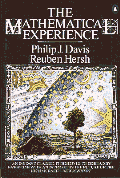
The Mathematical Experience |
by Philip J Davis & Reuben Hersh |

6.Comparative Aesthetics (p298)
WHAT ARE THE ELEMENTS that make for creativity? Is it a deep analytic ability
deriving from ease of combinatorial or geometric visualization - a mind as
restless as a swarm of honeybees in a garden, flitting from fact to fact,
perception to perception and making connections, aided by a prodigious memory-a
mystic intuition of how the universe speaks mathematics -a mind that operates
logically like a computer, creating implications by the thousands until an
appropriate configuration emerges?
Or is it some extralogical principle at work, a grasp and a use of metaphysical
principles as a guide? Or, as Henri Poincaré thought, a deep appreciation
of mathematical aesthetics?
There is hardly a science of mathematical aesthetics. But we can look at
an instance and discuss it at length. We can get close to the reason for
Poincaré's assessment. I shall take a famous mathematical theorem,
one with a high aesthetic component, and present two different proofs of
it.
The theorem is the famous result of Pythagoras that
Ö2 is not a fraction. The first proof
is the traditional proof.
Proof I. One supposes that
Ö2 = p/q where p and q
are integers. This equation is really an abbreviation of 2
=p2/q2 . One supposes that p and q are
in lowest terms, i.e. they have no common factor. (For if they do, strike
it out.) Now 2 =p2/q2 implies p2
=2q2 . Therefore p2 is an even number. Therefore
p is even (for if it were odd, p2 would be odd since
odd x odd = odd). If p is even it is of the form p = 2r, so
that we have (2r)2 = 2q2 or 4r2
= 2q2 or q2 = 2r2 . Thus, as
before, q2 is even so that q must be even. Now we
are in a logical bind, for we have proved that p and q are
both even, having previously asserted that they have no common factor. Thus,
the equation Ö2 = p/q must be
rejected if p, q are integers.
The second proof is not traditional and is argued a bit more loosely.
Proof II. As before, suppose that p2
=2q2. Every integer can be factored into primes, and we suppose
this has been done for p and q . Thus in
p2 there are a certain number of primes doubled up (because
of p2 = p . p). And in q2 there are a
certain number of doubled-up primes. But (aha!) in 2
. q2 there is a 2 that has no partner.
Contradiction.
I have no doubt that nine professional mathematician,out of ten would say
that Proof II exhibits a higher level of aesthetic delight. Why? Because
it is shorter? (Actually, we have elided some formal details.) Because, in
comparison, Proof I with its emphasis on logical inexorableness seems heavy
and plodding? I think the answer lies in the fact that Proof II seems to
reveal the heart of the matter, while Proof I conceals it, starting with
a false hypothesis and ending with a contradiction. Proof I seems to be a
wiseguy argument; Proof II exposes the "real" reason. In this way,the aesthetic
component is related to the purer vision.
Further Reading |
| Chaos | Quantum | Logic | Cosmos | Conscious | Belief | Elect. | Art | Chem. | Maths |